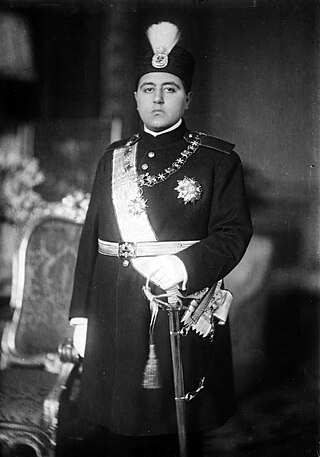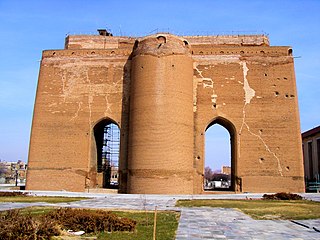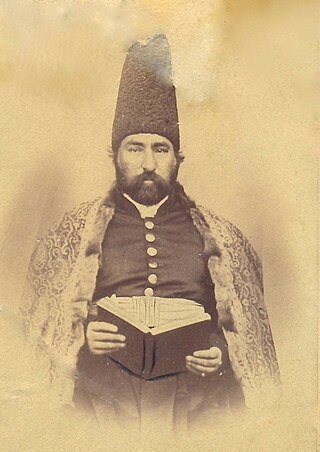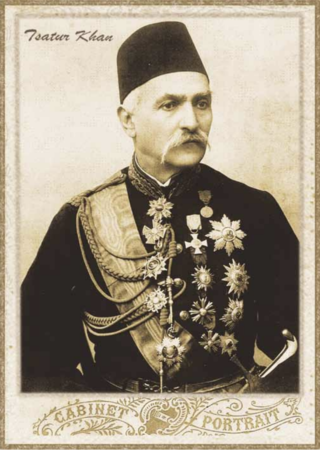This article needs additional citations for verification .(September 2015) |
| |||||
| Decades: | |||||
|---|---|---|---|---|---|
| See also: | Other events of 1911 Years in Iran | ||||
The following lists events that have happened in 1911 in the Qajar dynasty in Iran.
This article needs additional citations for verification .(September 2015) |
| |||||
| Decades: | |||||
|---|---|---|---|---|---|
| See also: | Other events of 1911 Years in Iran | ||||
The following lists events that have happened in 1911 in the Qajar dynasty in Iran.

Abbas Mirza was a Qajar crown prince of Iran. He developed a reputation as a military commander during the Russo-Persian War of 1804–1813 and the Russo-Persian War of 1826–1828, which however proved disastrous for Persia, as well as through the Ottoman–Persian War of 1821–1823. He is furthermore noted as an early modernizer of Persia's armed forces and institutions, and for his death before his father, Fath Ali Shah.

Tabriz is a city in the Central District of Tabriz County, in the East Azerbaijan province of northwestern Iran. It serves as capital of the province, the county, and the district. It is the sixth-most-populous city in Iran.

Ahmad Shah Qajar was the Shah of Persia (Iran) from 16 July 1909 to 15 December 1925, and the last ruling member of the Qajar dynasty.

Mohammad Shah was the third Qajar shah of Iran from 1834 to 1848, inheriting the throne from his grandfather, Fath-Ali Shah. From a young age, Mohammad Mirza was under the tutelage of Haji Mirza Aqasi, a local dervish from Tabriz whose teachings influenced the young prince to become a Sufi-king later in his life. After his father Abbas Mirza died in 1833, Mohammad Mirza became the crown prince of Iran and was assigned with the governorship of Azarbaijan. After the death of Fath-Ali Shah in 1834, some of his sons including Hossein Ali Mirza and Ali Mirza Zel as-Soltan rose up as claimants to the throne. With the support of English and Russian forces, Mohammad Shah suppressed the rebellious princes and asserted his authority.

Fath-Ali Shah Qajar was the second Shah (king) of Qajar Iran. He reigned from 17 June 1797 until his death on 24 October 1834. His reign saw the irrevocable ceding of Iran's northern territories in the Caucasus, comprising what is nowadays Georgia, Dagestan, Azerbaijan, and Armenia, to the Russian Empire following the Russo-Persian Wars of 1804–1813 and 1826–1828 and the resulting treaties of Gulistan and Turkmenchay. Historian Joseph M. Upton says that he "is famous among Iranians for three things: his exceptionally long beard, his wasp-like waist, and his progeny."

The Battle of Krtsanisi was fought between the army of Qajar Iran (Persia) and the Georgian armies of the Kingdom of Kartli-Kakheti and Kingdom of Imereti at the place of Krtsanisi near Tbilisi, Georgia, from September 8 to September 11, 1795, as part of Agha Mohammad Khan Qajar's war in response to King Heraclius II of Georgia’s alliance with the Russian Empire. The battle resulted in the decisive defeat of the Georgians, capture, and complete destruction of their capital Tbilisi, as well as the temporary absorption of eastern Georgia into the Iranian empire.

Arg of Tabriz, is the remnants of a large acropolis fortification and city wall in downtown Tabriz, Iran. Its structure is visible from far distances in downtown Tabriz, if not blocked by the newly erected highrise buildings.

The Russo-Persian War of 1826–1828 was the last major military conflict between the Russian Empire and Qajar Iran, which was fought over territorial disputes in the South Caucasus region.

Yeprem Khan, born Yeprem Davidyan, was an Iranian-Armenian member of the Armenian Revolutionary Federation (ARF), revolutionary leader and a leading figure in the Constitutional Revolution of Iran.

Bahman Mirza was a Qajar prince, literary scholar, and writer who lived in Iran and later the Russian Empire. The fourth son of the former crown prince Abbas Mirza, his career in Iran was marked by several governorships, including the province of Azerbaijan (1841–1847).

Prince Khosrow Mirza Qajar was the seventh son of Abbas Mirza and grandson of Fath-Ali Shah, King of Iran.
1921 Persian coup d'état, known in Iran as 3 Esfand 1299 coup d'état, refers to several major events in Qajar Persia in 1921, which eventually led to the deposition of the Qajar dynasty and the establishment of the Pahlavi Empire as the ruling house of the country in 1925.
Ali Akbar Bahman was an Iranian diplomat and politician during the Qajar and Pahlavi eras.

The Tabriz Khanate was a Caucasian Khanate from 1757 to 1799, centered around Tabriz and led by members of the Turkified Kurdish Donboli tribe.

The Guarded Domains of Iran, commonly called Qajar Iran, Qajar Persia or the Qajar Empire, was the Iranian state under the rule of the Qajar dynasty, which was of Turkic origin, specifically from the Qajar tribe, from 1789 to 1925. The Qajar family took full control of Iran in 1794, deposing Lotf 'Ali Khan, the last Shah of the Zand dynasty, and re-asserted Iranian sovereignty over large parts of the Caucasus. In 1796, Agha Mohammad Khan Qajar seized Mashhad with ease, putting an end to the Afsharid dynasty. He was formally crowned as Shah after his punitive campaign against Iran's Georgian subjects.
The Khoy Khanate, also known as the Principality of Donboli, was a hereditary Kurdish khanate around Khoy and Salmas in Iran ruled by the Donboli tribe from 1210 until 1799. The khanate has been described as the most powerful khanate in the region during the second half of the 18th century. The official religion of this principality was originally Yezidism, until some rulers eventually converted to Islam. The principality has its origins under the Ayyubid dynasty and was ultimately dissolved in 1799 by Abbas Mirza. During this period, the status of principality oscillated between autonomous and independent.

Fazel Khan Mohammad Garrusi was a poet and secretary under Fath-Ali Shah Qajar and Mohammad Shah Qajar. From 1838, he spent his remaining years in Tiflis in the Russian Empire, having fled Iran due to the schemes of the vizier of Mazandaran, Asadollah Navai.

The Iranian Enlightenment, sometimes called the first generation of intellectual movements in Iran, brought new ideas into traditional Iranian society from the mid-nineteenth to the early twentieth century. During the rule of the Qajar dynasty, and especially after the defeat of Iran in its war with the Russian Empire, cultural exchanges led to the formation of new ideas among the educated class of Iran.The establishment of Dar ul-Fonun, the first modern university in Iran and the arrival of foreign professors, caused the thoughts of European thinkers to enter Iran, followed by the first signs of enlightenment and intellectual movements in Iran.

Tsatur Khan was an Iranian general, envoy to Russia, and advisor to Shah Mozaffar ad-Din Qajar, the fifth Qajar shah (king) of Iran. He was a close friend of Grand Duke Michael Nikolaevich of Russia.
Ughurlu Khan or Oghurlu Khan was a claimant to Khanate of Ganja and a member Ziyadoghlu Qajar, a clan of the Qajar tribe.